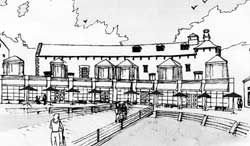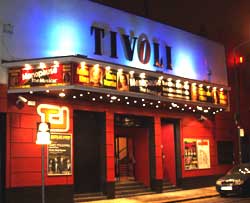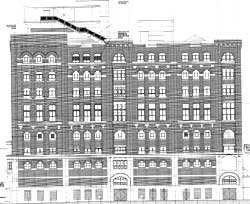Presentation 14 November 2007

The Event
This was the presentation by the John Thompson Partners team of the results of the three neighbourhood consultations, the jumbo meeting on 9 & 10 November, and contacts with other stakeholders. These had been worked up leading to a strategy for the development/regeneration of the area. The presentation reported on the consultations and outlined the proposed strategy.
The presentation took place in St Catherine's Church (CORE) on 14 November from 7pm until nearly 10pm. It was by far the best attended of the meetings I had been at to date.
Content
 The presentation made a very forceful case for what was, effectively, a refined version of the proposals put forward by the residents during the earlier sessions. It was clear that the team had done a very thorough analysis of what was possible, drawing on the strengths of the area and taking the wishes of residents on board.
The presentation made a very forceful case for what was, effectively, a refined version of the proposals put forward by the residents during the earlier sessions. It was clear that the team had done a very thorough analysis of what was possible, drawing on the strengths of the area and taking the wishes of residents on board.Specific areas for fairly radical regeneration were (i) liberties markets, (ii) rehousing and community development at Swinging Boat Square, and (iii) the old canal harbour. These would be in the context of linking the Cathedrals to the harbour area on an east-west tourist trail, as well as capturing spinoff from some of the 800,000 visitors to the Guinness Storehouse. Interaction between resident communities would be encouraged and there would be an overall improvement in the quality of the whole area.
 The historical heritage of the area would be a major factor informing development and forming a basis for attracting tourists. An effort would be made to retain a sympathetic skyline by gradually stepping up heights from the low rise Coombe to the "high rise" Guinness warehouses. Development could be phased in a way that would cause the least possible disruption to the existing residents.
The historical heritage of the area would be a major factor informing development and forming a basis for attracting tourists. An effort would be made to retain a sympathetic skyline by gradually stepping up heights from the low rise Coombe to the "high rise" Guinness warehouses. Development could be phased in a way that would cause the least possible disruption to the existing residents.
Form
The presentation was a tremendous tour de force. It drew heavily on maps which had been worked up at the week-end workshops, photos taken on the workshop walk-abouts, and themes and suggested actions from the consultations and workshops. It presented a brief historical resum� of some of the highpoints in the area's history. And, finally, with a very effective use of animated maps (� la powerpoint) and sketch overlays on custom aerial photos, it sketched out a possible strategy for the imaginative regeneration of the area.
Comment
- the presentation
Certainly the content of the meetings I had attended was very well encapsulated in the presentation and the use of the technology was exemplary, always enhancing the material and never intrusive or simply there for its own sake.
The experience and professionalism of the team was evident throughout this whole process: their totally non-tech handling of the neighbourhood consultations; anchoring the workshops on maps drawn up by the participants; and the discreet and effective use of the technology for this presentation.
- the Developers
 "I'm a Developer, get me out of here!"
"I'm a Developer, get me out of here!" I'm told there were developers at the jumbo weekend. If there were they were very quiet people. I mentioned this to a resident and the reply was to the effect of "why should they engage here if they can deal with the Council directly". Or perhaps they just didn't want to end up like poor Robert Emmet across the street. The people hereabouts have a strong sense of history. Still, it's a bit ominous.
- the City Council
The potential fly in the ointment here is the City Council. Their stock is low among residents as a result of broken promises in the past. It is not clear, on the basis of the type of development that has been permitted in the area in recent times, that they will have the gumption, or even the will, to ensure that development in this area is not purely developer driven and further undermining of existing communities. This is, after all, only one of the many areas for which they are responsible and, to mix a metaphor, the Celtic Tiger is sort of running out of steam.
 Having said that, they are the only body which can ensure some sort of rational development of the area and they are the guardians of the public interest who should be setting, and enforcing, the parameters for development in the interest of the community.
Having said that, they are the only body which can ensure some sort of rational development of the area and they are the guardians of the public interest who should be setting, and enforcing, the parameters for development in the interest of the community.It was said at the presentation that the Council was aware of the need to restore local trust. It had therefore committed itself to the following "deliverables" in the short term as a measure of its good faith: (i) a new tourist guide to the heritage of the liberties; (ii) streetscape improvements in Thomas St.; (iii) landscape and lighting improvements to Park Terrace; and (iv) a number of audit studies of aspects of the area relevant to the strategy. They are promising extensive consultation with City Council tenants on their housing needs and on rehousing options on estates where redevelopment is being considered.
There will be opportunities for the broader range of local people to continue to be involved through participation in a new Community Forum, and this process will kick off on 15 January next.
Let's hope that this all works out. I am still a bit uneasy about the lack of a clear statement of what may be the limits, if any, imposed on a process of change or regeneration, by irreversible developments already in place or existing land ownership/planning permissions. The City Council's otherwise excellent online planning applications database does not appear to be always up to date in this area.
Nevertheless, there has been no small amount of effort, time and money put into these consultations to date, and purely on the basis of future accountability for this investment, the Council will surely be obliged to pay some heed to its outcome.
You can check out future developments regarding the consultation process here.

Bounded on the north by James's/Thomas St., south by Cork St.,
west by the hospital and east by Francis St.
